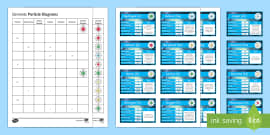

Periodic table chemistry board game how to#
Playing cards are created from the Tables shown starting on the next page, by folding along the line that divides the question from the answer, then cutting out each row and either clipping or gluing the front question side of the card onto the back answer side.Īs for materials, I had students bring in their own player token (e.g., small coin, pebble, button, poker chip) and die. For those students who did not bring in the requested material, I provided a paper-based die template (see first link below), complete with instructions on how to make their own paper die, as well as different kinds of lentils (for useĪs a player token). In the case of final exam review, students mayĮven decide to choose the board based on which unit they need most review on. Alternatively, one can create different board games that collectively address an entire unit or even several units of study in preparation for a unit test or final exam, respectively. If several different board games are prepared, then students have an opportunity to switch board games and resume playing. Finally, regular-based questions can be of moderate difficulty, somewhere in between snakes questions and ladders questions.

“Ladders” questions may be grouped as more difficult questions that require students to think through concepts and provide an extended response. “Snakes” questions can be grouped as easy questions that require a short, straight-forward response. Depending on how many questions and corresponding answers you and/or students generate, several different board games can be prepared wherein each game comes with a unique set of “snakes,” “ladders”, and regular-based questions and answers of varying levels of difficulty. This game can be played for the first portion of a period, just prior to administering a quiz or for an entire period, depending on how large scale you go. This Snakes and Ladders activity is a fun and engaging way to challenge students through fostering critical thinking skills as they review material related to periodic trends. Licensing under Creative Commons.Ĭurriculum Connection: Grade 11 University Chemistry (SCH3U), Matter, Chemical Trends, and Chemical Bonding Unit Introduction


 0 kommentar(er)
0 kommentar(er)
